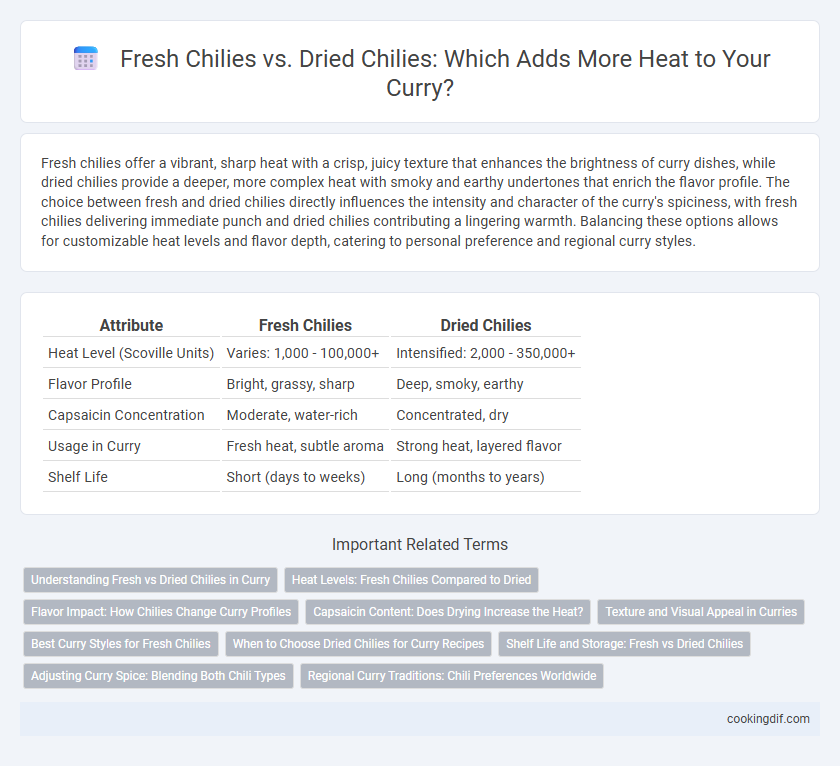Fresh chilies offer a vibrant, sharp heat with a crisp, juicy texture that enhances the brightness of curry dishes, while dried chilies provide a deeper, more complex heat with smoky and earthy undertones that enrich the flavor profile. The choice between fresh and dried chilies directly influences the intensity and character of the curry's spiciness, with fresh chilies delivering immediate punch and dried chilies contributing a lingering warmth. Balancing these options allows for customizable heat levels and flavor depth, catering to personal preference and regional curry styles.
Table of Comparison
| Attribute | Fresh Chilies | Dried Chilies |
|---|---|---|
| Heat Level (Scoville Units) | Varies: 1,000 - 100,000+ | Intensified: 2,000 - 350,000+ |
| Flavor Profile | Bright, grassy, sharp | Deep, smoky, earthy |
| Capsaicin Concentration | Moderate, water-rich | Concentrated, dry |
| Usage in Curry | Fresh heat, subtle aroma | Strong heat, layered flavor |
| Shelf Life | Short (days to weeks) | Long (months to years) |
Understanding Fresh vs Dried Chilies in Curry
Fresh chilies provide a vibrant, sharp heat with fruity undertones that enhance the complexity of curry dishes, while dried chilies offer a deeper, smokier heat that intensifies the overall flavor profile. The capsaicin concentration in dried chilies is higher due to moisture loss, resulting in a more potent spiciness ideal for slow-cooked curries. Selecting between fresh and dried chilies depends on the desired heat intensity and flavor depth, as well as the cooking method used in traditional curry recipes.
Heat Levels: Fresh Chilies Compared to Dried
Fresh chilies typically deliver a more immediate, sharp heat due to their high water content and active capsaicin oils, which intensify the spiciness upon biting. Dried chilies often possess a deeper, more concentrated heat as dehydration increases capsaicin concentration and melds flavors, resulting in a richer, smoky spiciness. Heat levels in fresh versus dried chilies vary widely depending on the variety, with dried types frequently rated higher on the Scoville scale due to their concentrated capsaicin profile.
Flavor Impact: How Chilies Change Curry Profiles
Fresh chilies deliver a vibrant, sharp heat that brightens curry dishes with crisp, grassy notes enhancing the overall freshness. Dried chilies provide deeper, smokier flavors and richer heat levels, contributing complex earthy undertones that intensify curry profiles. Choosing between fresh and dried chilies significantly influences the balance between brightness and depth, shaping the curry's final aromatic and taste characteristics.
Capsaicin Content: Does Drying Increase the Heat?
Dried chilies generally have a higher concentration of capsaicin per unit weight compared to fresh chilies due to moisture loss during drying, which intensifies the heat. However, the actual heat intensity can vary based on the chili variety and drying method, as some capsaicin can degrade with excessive heat or prolonged drying. Fresh chilies typically offer a more vibrant, immediate heat, while dried chilies provide a deeper, more concentrated spiciness ideal for curries and chili powders.
Texture and Visual Appeal in Curries
Fresh chilies add a vibrant color and crisp texture to curries, enhancing both visual appeal and mouthfeel. Dried chilies contribute a deeper, smoky heat with a softer texture once rehydrated, creating a rich, layered flavor profile. Choosing between fresh and dried chilies depends on the desired intensity of heat and the balance between visual brightness and textural complexity in the dish.
Best Curry Styles for Fresh Chilies
Fresh chilies provide vibrant, sharp heat and bright flavor, ideal for Thai and South Indian curries that emphasize fresh, aromatic ingredients. Their crisp texture enhances dishes like Thai green curry and Kerala-style fish curry, offering a lively, spicy kick that dried chilies can't replicate. Curries relying on fresh herbs and coconut milk benefit most from the zesty heat of fresh chilies, balancing richness without overpowering subtle flavors.
When to Choose Dried Chilies for Curry Recipes
Dried chilies provide a deeper, more complex heat and smoky flavor ideal for slow-cooked curries that benefit from prolonged simmering. Opt for dried chilies when aiming to develop rich, layered spice profiles in dishes like vindaloo or mole-inspired curries. Their concentrated heat and distinct aroma enhance the robustness of curry sauces, making them essential for authentic texture and taste.
Shelf Life and Storage: Fresh vs Dried Chilies
Fresh chilies offer vibrant heat with a short shelf life of about one to two weeks when refrigerated, requiring airtight containers to maintain moisture and flavor. Dried chilies provide concentrated heat and a significantly longer shelf life, often lasting six months to a year when stored in cool, dark, and dry conditions. Proper storage techniques for dried chilies, such as using sealed jars, prevent moisture absorption and preserve their intense heat and fragrance for extended periods.
Adjusting Curry Spice: Blending Both Chili Types
Blending fresh chilies and dried chilies in curry allows precise control over heat intensity and flavor depth. Fresh chilies contribute vibrant, sharp heat, while dried chilies add smoky, complex undertones essential for a balanced curry spice profile. Combining these chili types enhances the curry's spiciness and enriches its aromatic character for a well-rounded taste experience.
Regional Curry Traditions: Chili Preferences Worldwide
Fresh chilies are favored in South Indian and Thai curries for their bright, vibrant heat and aromatic flavor, enhancing dishes like Chettinad and Thai green curry. Dried chilies, commonly used in Mexican and North Indian cuisine, provide a deeper, smoky heat essential to recipes such as Vindaloo and Mole sauces. Regional curry traditions highlight these preferences, where fresh chilies deliver sharp, immediate spice while dried varieties contribute complex, lingering heat and rich color.
Fresh chilies vs Dried chilies for heat Infographic

 cookingdif.com
cookingdif.com